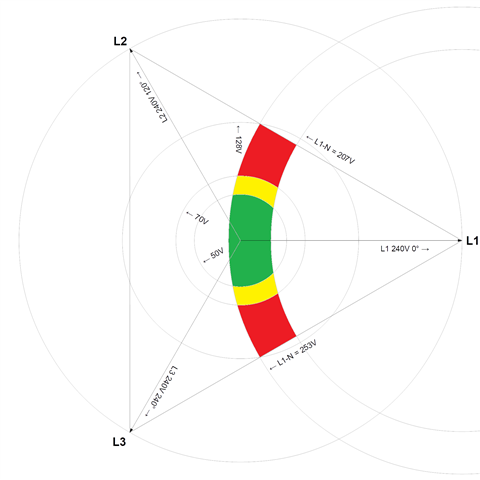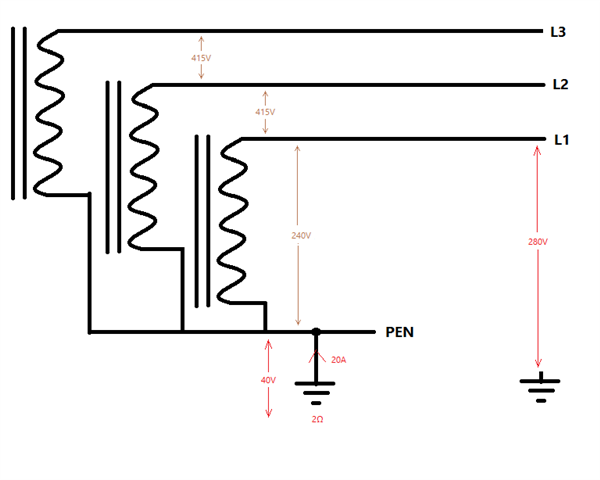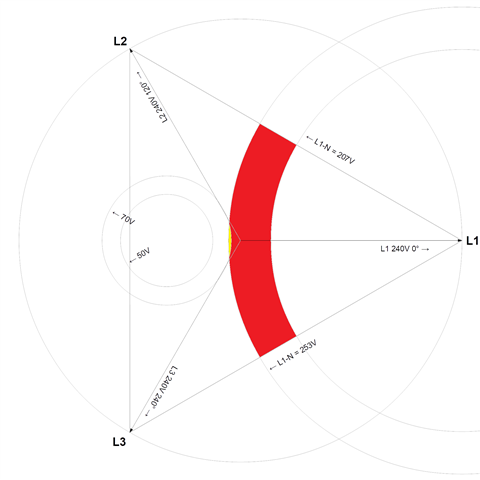Following on from from the discussion Open PEN detection for 722.411.4.1 (iv) - and the various discussions about uncleared TT earth faults and similar causing the substation earth reference to wander about, I've been thinking (bad idea I know, but...) and there's something that's been troubling me. Maybe someone can reassure me.
These open-pen devices (for the (iv) option) work by measuring the L-N voltage, and using that to approximate the voltage difference between N/PE/PEN and true earth. Previously we discussed how the nature of the 3-phase connected loads (either 3-phase loads or combinations of single phase loads) could cause the severed N to wander about the place - and not all the combinations where it was more than 70V away from true earth would be detected by the L-N voltage monitoring. We had this (phasor) diagram:

(Green was the bit where the device remains connected with touch voltages <50V, yellow where it remains connected despite touch voltages >50V and red >70V)
So, I think, in effect the monitor is effectively using the substation's earth electrode as its reference for true Earth, offset by the line voltage, but still ultimately referenced to the substation's electrode. In the above diagram the substation's Earth is the centre point.
So I now add in the other thought - say we had some current returning to the substation's star point via the general mass of the earth. Probably quite likely in an Open-PEN situation, especially where there are still a few true extraneous-conductive-parts about, or someone's up with the latest version of BS 7671 and installed an additional electrode on their PME installation. We'd then create a p.d. across the soil surrounding the substation's electrode(s). Exact values would vary tremendously, as substation electrode resistance values could be anything from well below 1Ω to nearly 20Ω. For the sake of illustration say we had a substation electrode say 2Ω and 20A of return current - V=IR so our substation star point would be offset by 40V from true Earth. The phase angle of the return current would depend on the mix of loads across the 3 phases - but for the sake of argument (and because it makes the diagrams a bit simpler to draw) lets say it's in phase with the line our charger is on. So "0v" at the substation is really 40V and L1's "240V" is really 280V (similarly the other two phases will be offset, but by odd angles which makes calculating the exact values tiresome). We still have the normal 230/400V nominal relationship between conductors, but they're all offset from Earth by that 40V.

In a simple single phase system the additional resistance on the broken N but now through the general mass of the earth would severely limit the current that could flow through the loads, so the voltage across the loads would collapse, almost certainly pushing the open-PEN device to trip. But with a 3-phase supply I'm thinking that the bulk of the load currents is supplied between lines - from one line, via "artificial star point" of the far end of the broken PEN to the other lines, so isn't limited by the ground resistance, and so voltages across loads is likely to hold up fairly well - the ground resistance only affecting the N current, resulting from the imbalance of the loads, which may be small in comparison to the load currents, so only have a small effect on the voltage on the load end of the severed PEN conductor.
So now the true earth point is 40V to the left of the centre of our 3-phase triangle, which I think means the open-PEN device is even more likely to mos-interpret unsafe touch voltages as acceptable.

... so have I gone wrong somewhere?
- Andy.